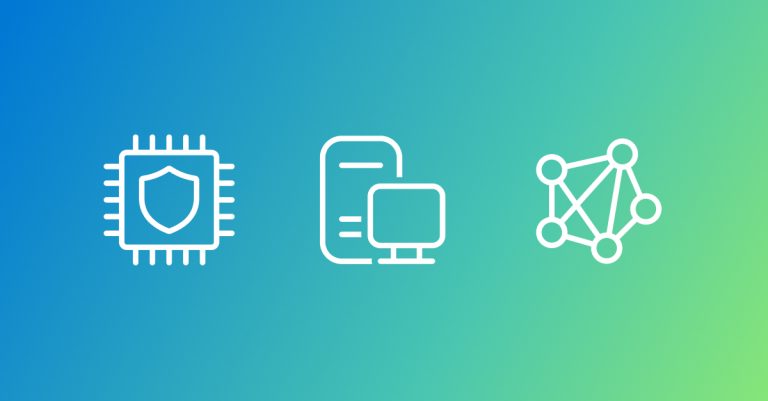
Cloud computing delivers scalable and cost-effective compute resources to a wide range of customers. The ability for cloud providers to share components of the hardware stack across customers, or tenants, is essential for running efficient cloud systems. For example, modern central processing units (CPUs) pack hundreds of physical hardware threads sharing terabytes of dynamic random-access memory (DRAM), which can be flexibly assigned to many independent virtual machines (VMs).
Preventing tenants from snooping on others who share the same hardware requires security mechanisms. Microsoft Azure (opens in new tab) provides strong protection via comprehensive architectural isolation through access control mechanisms implemented across the cloud platform, including the hardware and the hypervisor. Confidential computing (opens in new tab) powered by trusted execution environments further hardens architectural isolation via hardware memory encryption to protect tenants even against privileged attackers.
A changing threat landscape
Even with perfect architectural isolation, sharing microarchitectural resources, such as CPU caches and DRAM row buffers, can leak small amounts of information, because interference (due to sharing) leads to variations in the latency of memory accesses. This gives rise to so-called microarchitectural side-channel attacks where a malicious tenant can learn information about another tenant, in the worst case: their cryptographic keys.
Microsoft Azure protects tenants and critical infrastructure against currently practical side-channel attacks. For example, side-channels in on-core resources (e.g., buffers, predictors, private caches) are comprehensively (opens in new tab) mitigated by Hyper-V HyperClear (opens in new tab) via core scheduling, microarchitectural flushing and scrubbing, and virtual-processor address space isolation; and our cryptographic libraries are carefully hardened to prevent any secrets from being leaked via microarchitectural side-channels.
However, the threat landscape is changing. First, side-channel attacks are becoming increasingly sophisticated: For example, recent academic research (opens in new tab) has shown that even cache-coherence directories can be exploited to leak information across cores. Second, future CPUs are likely to employ increasingly sophisticated microarchitectural optimizations, which are prone to new kinds of attacks: For example, the recently introduced data-dependent prefetchers have already been found to leak information (opens in new tab).
In Azure Research’s Project Venice, we are investigating principled defenses, to be prepared in case such emerging attacks start posing a risk to Azure customers.
Preventing microarchitectural side-channels with resource-exclusive domains
In a research paper (opens in new tab), which has received a distinguished paper award at the ACM Conference on Computer and Communications Security (ACM CCS’24 (opens in new tab)), we present a system design that can prevent cross-VM microarchitectural side-channels in the cloud. Our design provides what we call resource-exclusive domains, which extend the architectural abstraction of private physical threads and private memory to the microarchitectural level. That is, resource-exclusive domains guarantee isolation even against powerful attackers that try to mount side-channel attacks on shared microarchitectural resources.
Our approach builds on isolation schemes, a novel abstraction of the way a CPU shares microarchitectural structures between its physical threads. Isolation schemes can be used by the hypervisor and host operating system to assign physical threads and physical memory pages, eliminating the risk of information leakage across resource-exclusive domains. Technically, for a given assignment of physical threads to resource-exclusive domains, the isolation scheme partitions each microarchitectural resource that is shared between domains (as this would leak information), but without partitioning resources that are private to a domain (as this would affect performance). We achieve this using hardware mechanisms, if available, and multi-resource memory coloring, if not.
In a complementary research paper (opens in new tab) (appearing at ACM CCS’24 (opens in new tab)), we provide the theoretical foundations and practical algorithms for computing such multi-resource memory coloring schemes for existing microarchitectures, as well as design patterns for future microarchitectures to support a large number of resource-exclusive domains.
We have implemented our approach in a research prototype based on Microsoft Hyper-V for a modern cloud chiplet-based CPU, AMD EPYC 7543P, that supports VM-level trusted execution environments. Using a collection of microbenchmarks and cloud benchmarks, we demonstrate that our approach eliminates all identified side-channels and incurs only small performance overheads. For example, when allocating resources at chiplet and channel granularity (i.e., coupling a chiplet with one of the local DRAM channels) we observe an overhead of less than 2%; and only up to 4% when allocating resources at chiplet granularity and coloring with 2MB pages.
Co-designing cloud platforms for future microarchitectural isolation
To validate the effectiveness and practicality of our approach, we inferred isolation schemes for a single CPU by reverse-engineering its microarchitecture. This approach is incomplete and does not scale to the diverse hardware fleet available in the cloud. We are working with CPU vendors to develop isolation schemes for future CPUs, which will then be exposed via the hardware interface for consumption by the hypervisor’s hardware abstraction layer. In this way, we will be able to reap the benefits of microarchitectural performance optimizations while continuing to provide strong security guarantees to cloud tenants.
Additional Contributors
Cédric Fournet, Senior Principal Researcher
Jana Hofmann, Researcher
Oleksii Oleksenko, Senior Researcher



